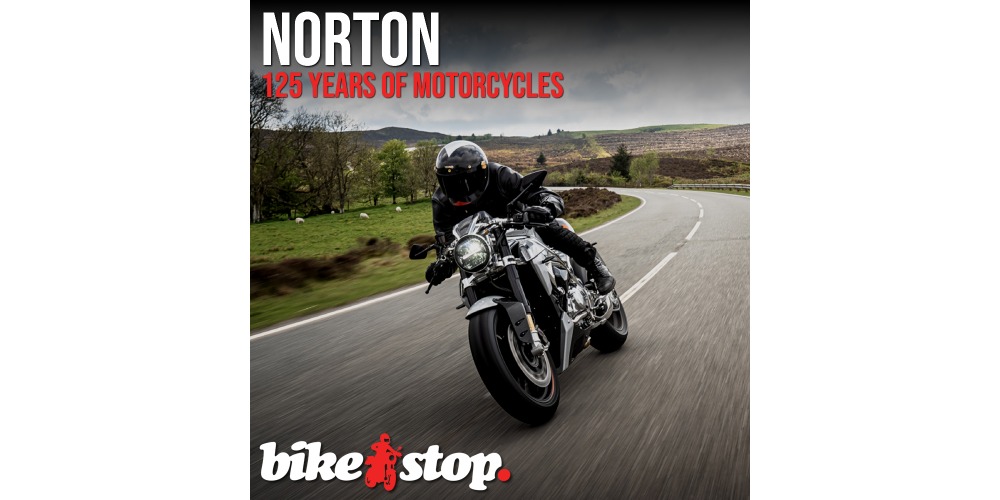Very recently, I was fortunate enough to find myself straddling Norton's upcoming V4CR. Unfortunately, I didn't have the keys and was under the watchful eye of Norton staff but wow, what a machine. There's something rather special about Norton's limited edition cafe racer. The meticulously-finished carbon fibre, chunky machined billet and beautiful welds ooze a quality that's all too rare in the world of motorcycles. Furthermore, it's retro done right. The hourglass silhouette and forward angle of the engine imbue it with an appearance out of time; from a distance, it would be hard to determine its era, but the closer you get, the more modern it appears. It's a beautiful thing.
The Norton name has been around for a long time, and anyone with even the slightest interest in motorcycles will have heard of the brand. However, not everyone will know of its rich history and how the company has transformed over the years. With that in mind, I thought I'd take a peek at Norton and provide a potted history.
The Early Years (1898-1918)
The origins of Norton Motorcycles can be traced back to 1898 when James Lansdowne Norton—known as 'Pa' to his mates—founded the company in Birmingham as a manufacturer of "fittings and parts for the two-wheel trade". However, it wasn't until five years later, in 1902, that Norton produced its first motorcycle, the Energette, featuring a 143cc single-cylinder Clement engine. At this stage, the bikes were little more than modified bicycle frames with tiny motors and a fuel tank, but you have to start somewhere.
In 1907, a Norton piloted by Rem Fowler entered the very first Isle of Man TT in the twin-cylinder class and won. With a 5hp Peugeot engine tucked inside the frame, Fowler completed the 10-lap, 158-mile course in 4:21:52.8 at an average speed of 36.21 mph. It may not sound speedy by modern standards, but considering the 2nd and 3rd place speeds of 32.3mph and 30.5mph, it's fair to say the Norton was swift. In the same year as its inaugural TT win, Norton moved to larger premises in Birmingham and began manufacturing its own engines. Two models were available from 1908; 490cc and 633cc. The latter engine, known as the Big 4, would remain in production, with few changes, until 1954, reaching the dizzying height of 14hp.
With the nation's growing love for motorcycling, Norton quickly became part of the public consciousness. There was even a time you could stroll into Harrods and buy a brand-new Norton. However, by 1913, things were looking a little shaky, and so Norton sought investment from its main creditor, Bob Shelley. It was at this point that Norton, together with Shelley, formed Norton Motors Ltd. Shelley also brought along with his brother-in-law and tuner, Dan O'Donovan, who went on to develop Norton's first production racer, the BS490. With a new company, the brand required a new logo. The "Curly N" logo, which first appeared on the front of the 1914 catalogue and continued to be featured on every Norton tank from 1916, was originally created by Pa Norton and his daughter Ethel.
Then followed a few years of international unpleasantness between 1914 and 1918. During the war period, Norton maintained the production of their 3.5 hp and Big 4 singles. However, in November 1916, the Ministry of Munitions issued an order that prohibited any further work on motorcycles or cars without a permit. Most motorcycle companies had already shifted towards producing munitions or aircraft parts or focused on exports. Norton, too, had been exporting and introduced a new version of their 633cc Big 4 called the 'Colonial Model' with increased ground clearance, an altered frame, a larger tank, greater clearance on mudguards, and a sturdy rear carrier.
War Efforts (1918-1945)
After the war, Norton motorcycles gained popularity and success, particularly in motorcycle racing. In 1922, Norton introduced the Model 18, featuring a new overhead-valve engine design. This model achieved considerable success in racing. The Isle of Man Senior TT witnessed its first victory with an average race speed of over 60 mph in 1924, thanks to rider Alec Bennett. These would be the last race wins witnessed by Pa Norton. Sadly, Norton passed away in 1925, aged just 56.
Following that, the CS1 was introduced. Initially created as a TT racer, it was eventually marketed as a replica road bike. In 1927, Alex Bennett participated in the CS1's inaugural TT race and emerged victorious. Later, Arthur Carroll developed a new overhead cam engine in 1930, which became the foundation for all OHC and DOHC Norton single-cylinder engines. Between 1930 and 1937, Norton emerged victorious in 78 out of 92 Grand Prix races. Additionally, of the nine Isle of Man TTs held from 1931 to 1939, Norton won an impressive seven times. These achievements significantly contributed to the brand's widespread recognition and popularity.
Unfortunately, at this point, due to an angry Austrian with a silly moustache, the world was plunged into war yet again. During the period from 1937 to 1945, Norton shifted its focus from racing to supporting the war effort. During the period from 1937 to 1945, Nortons accounted for almost a quarter of all British military motorcycles, with over 100,000 units produced. These were predominantly the WD 16H and WD Big Four, which featured a driven sidecar wheel.
Dominator and Commando (1946-1977)
Following the end of World War II, Norton shifted its focus back to producing civilian motorcycles and expanded its offerings over time. One notable addition in 1949 was the Norton Dominator, also known as the Model 7. This was a 500 cc twin-cylinder bike with pushrod operation designed by Bert Hopwood. It used a chassis based on the ES2 single model, featuring telescopic front and plunger rear suspension and an updated version of the gearbox known as the "lay-down" box. Norton included more modern styling elements such as sleeker mudguards and tanks to enhance the bike's overall look, resulting in a more premium twin-cylinder model. The Norton Dominator was introduced in 1951 with the Featherbed frame specifically for export markets as the Model 88. As demand for this frame grew, it eventually became a standard production model and was even adapted for other models, including the OHV single-cylinder machines.
Unfortunately, racing isn't a cheap hobby, and despite success in racing, the associated costs were taking a toll on the company. In 1953, Norton was acquired by Associated Motorcycles (AMC), which also owned renowned motorcycle brands such as AJS, Matchless, Francis-Barnett, and James. Eventually, in 1962, the Birmingham-based Norton factory at Bracebridge Street was shuttered, and production was shifted to AMC's Woolwich facility in southeast London. However, the acquisition brought certain benefits in terms of development and evolution. Better gearboxes and improved frames were all a part of the dividend.
The early 1950s marked a turning point for Norton Motorcycles by introducing the Featherbed Frame. Developed by the McCandless brothers, the Featherbed Frame showcased remarkable handling and stability, instantly capturing the attention of riders and enthusiasts. It provided a solid foundation for Norton's racing success, propelling them to numerous victories in prestigious competitions like the Isle of Man TT.
In 1956, Norton unveiled the Dominator Model 88, equipped with a parallel twin engine. This marked a significant departure from the traditional single-cylinder engines that Norton had relied on for years. The Dominator Series combined impressive power, reliability, and elegance, captivating riders and setting the stage for Norton's dominance in the market. This era also witnessed the introduction of the iconic "Manxman" and "Atlas" models, solidifying Norton's reputation as a premier motorcycle manufacturer.
The 1960s brought about a revolution in the motorcycle industry, and Norton seized the opportunity to innovate once again. In 1967, Norton introduced the legendary Commando model, quickly becoming an icon of British motorcycling. The Commando featured an innovative Isolastic system, effectively isolating the engine vibrations from the frame and providing a remarkably smooth and comfortable ride. This technological leap earned the Commando widespread acclaim and numerous accolades, including the prestigious "Motorcycle of the Year" award in 1968.
Over 55,000 Commando motorcycles were sold in the following decade, and it was awarded Motor Cycle News' Machine of the Year for five consecutive years. However, the rise in popularity of Japanese bikes led to the downfall of several renowned British motorcycle brands. The production of the Commando came to a halt in 1977, marking the end of an era.
Modern Era (1978-2019)
Brian Crighton, a notable figure in Norton's history, is credited with designing the first Norton rotary race bike in 1987. Crighton was not backed by the factory when he built the RCW588 race bike, but he relied on the Norton 588cc Interpol model used by the UK police force as his basis. When the bike placed third in its club race debut at Darley Moor, the factory realised that Crighton had created something extraordinary. The bike went on to win national races in 1988, with Steve Spray as the rider. JPS became the title sponsor for the 1989 season, and Steve Spray won the British Formula One Championship and the 750cc Supercup Champion on the JPS-sponsored RCW588.
In the 1990s, Steve Hislop won the 1992 Isle of Man Senior TT on his Abus Norton. He beat Carl Fogarty's Yamaha and secured the first victory for a British motorcycle in almost 30 years. This race is still considered one of the most impressive senior races. Two decades later, Ian Simpson replicated Steve Spray's success on the Duckham-sponsored Norton in the British Superbike race in 1994, marking a significant milestone in Norton's history. In 2012, Norton made a comeback and continued to compete until 2019, building upon the progress made in previous years. Their hard work paid off in 2018 when Josh Brookes broke the record for the fastest British bike on the SG7 at the Isle of Man TT, a remarkable achievement. The following year, Norton entered the lightweight category and raced with the Norton Superlight, with Peter Hickman at the helm, a TT lap record holder, finishing in eighth place.
The Present (2020-Today)
In April 2020, Norton Motorcycles was acquired by TVS Motor Company. With huge investment and bleeding edge facilities and technology, there's new life in Norton. Alonside the retro Commando 961, the V4SV and V4CR models are bikes of beauty, passion and soul. Sadly, as they're a little out of my price range (by a factor of two or three), I'll have to be content with the occasional straddling and ogling at the truly amazing fit and finish. They're something to behold.






